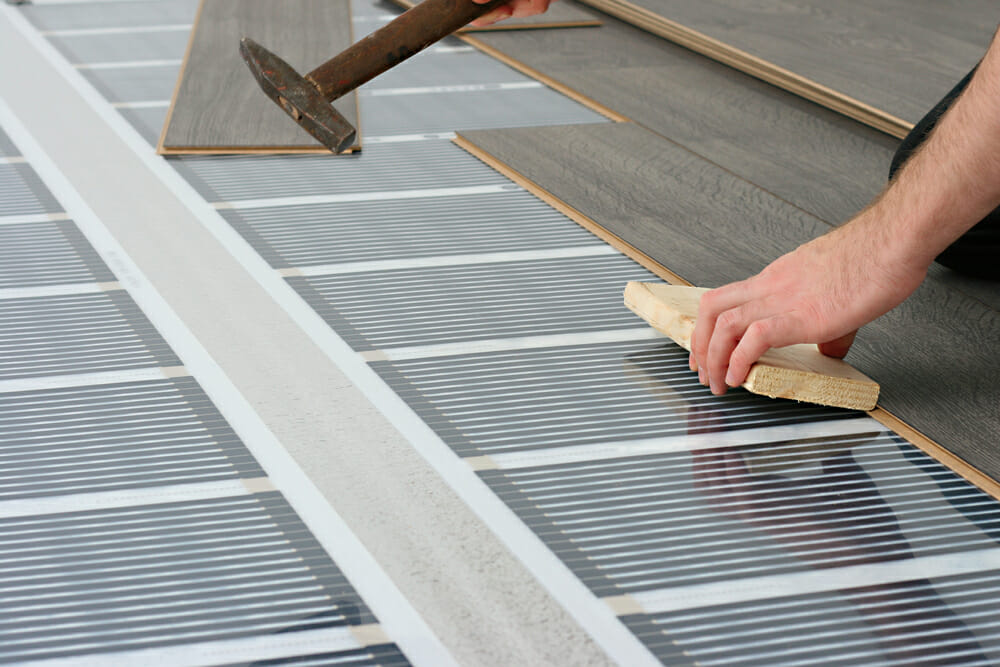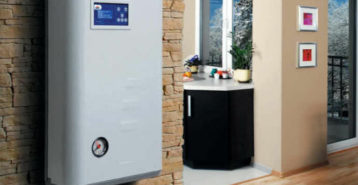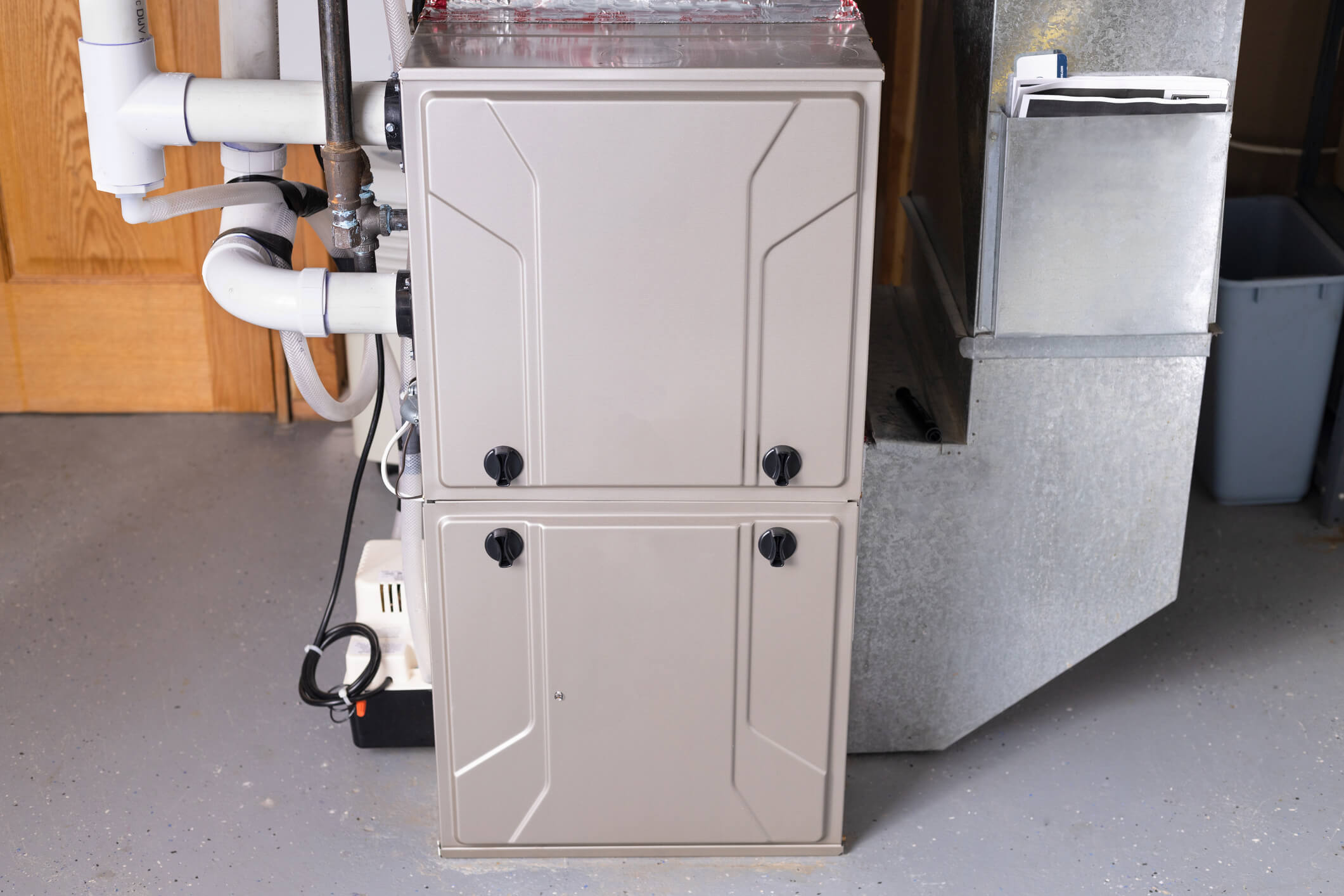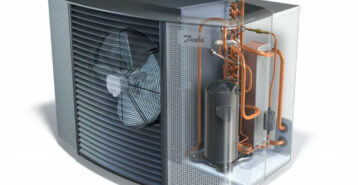Installing Radiant Floor Heating
Thinking about radiant floor heating installation? If you want warm floors, even room temperatures, and fewer visible vents or radiators, this could be a great fit. In this guide, we’ll explain what radiant heat is, how much it costs, how it works, the main types (electric and hydronic), the best systems, and quick answers to the questions homeowners ask most.
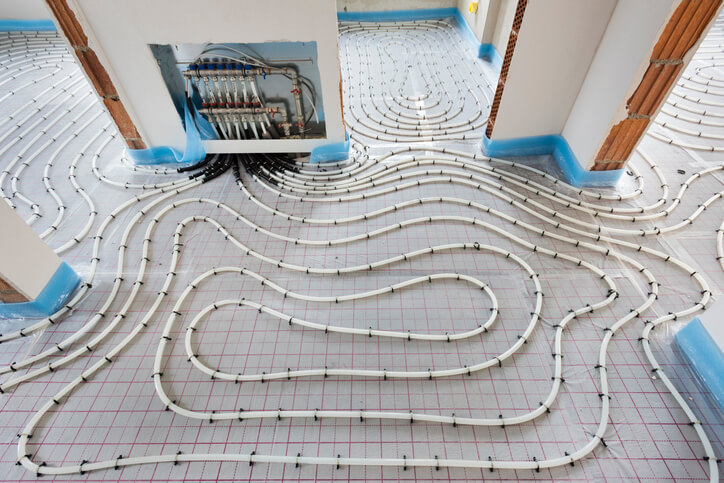
What Is Radiant Floor Heat
Radiant floor heating, also called underfloor heating, warms the surface you walk on and the room above it. Instead of blowing warm air through ducts, it gently heats the floor and radiates warmth upward. Homeowners love it for quiet operation, clean looks, and all-over comfort.
Underfloor Heating Cost
Your price depends on room size, floor type, and whether you choose electric mats or cables or hydronic (water-based) tubing. Costs rise if your contractor must remove old flooring, level the subfloor, add insulation boards, or upgrade electrical or boiler equipment.
Typical costs:
- Electric: $8 to $15 per square foot
- Hydronic: $6 to $20 per square foot (wider range due to boilers, manifolds, and pumps)
| Area (Typical Size) | Electric Installed Cost | Hydronic Installed Cost | Notes |
|---|---|---|---|
| Small Bathroom (40 to 60 square feet) | $500 to $1,200 | $700 to $1,400 | Electric is popular for fast warm-ups and simple retrofits. |
| Primary Bath (80 to 120 square feet) | $900 to $2,000 | $1,200 to $2,800 | Insulation boards under mats improve performance and comfort. |
| Kitchen (120 to 200 square feet) | $1,200 to $3,000 | $1,800 to $4,000 | Tile conducts heat well; confirm wood products are radiant-rated. |
| Open Living Area (250 to 400 square feet) | $2,000 to $5,000 | $2,500 to $6,500 | Larger rooms often favor hydronic for lower operating cost. |
| Whole-Home (1,500 to 2,000 square feet) | Usually not used whole-home | $12,000 to $35,000+ | Hydronic is the go-to for full homes or major remodels. |
Factors That Affect Radiant Floor Heating Installation Costs
You’ll pay more for:
- Flooring demolition and disposal
- Subfloor leveling and insulation boards (to push heat upward)
- Electrical work (dedicated circuit, GFCI, smart thermostat wiring) for electric systems
- Boiler or water-heater upgrades, manifolds, and pumps for hydronic systems
How Does Heated Flooring Work
Radiant systems warm the floor first, then the room. Electric systems use thin heating mats or cables powered by a thermostat. Hydronic systems circulate warm water through flexible tubing (often PEX) connected to a manifold and a heat source (boiler, combination boiler, high-temperature heat pump, or water heater). In both cases, insulation under the system reduces heat loss and shortens warm-up time.
Types of Floor Heating
Most homes fit one of two options: electric (best for single rooms and retrofits) or hydronic (best for large rooms and whole-home projects). Use this comparison table to pick what matches your space and budget.
| Feature | Electric Radiant | Hydronic (Water-Based) |
|---|---|---|
| Typical Installed Cost | $8 to $15 per sq. ft. | $6 to $20 per sq. ft. |
| Best For | Bathrooms, kitchens, single rooms, retrofits | Whole-home, additions, large rooms, new builds |
| Heat Source | Electric mats or cables | Boiler, combi boiler, water heater, or heat pump |
| Warm-Up Time | Fast in small rooms | Steady, great for large areas |
| Operating Cost | Higher per hour than hydronic | Lower per hour in larger spaces |
| Complexity | Low to moderate | Moderate to high (manifold, pumps, mixing valves) |
Electric Radiant Floor Heating
- What It Is: Thin mats or loose cables under the floor, controlled by a wall thermostat.
- Why Choose It: Easiest for small areas and remodels — minimal floor height change.
- Good to Know: You’ll want to budget for a dedicated electrical circuit and use insulation boards to improve performance.
Hydronic Floor Heating
- What It Is: Flexible tubing in the floor connected to a manifold and heat source. Warm water circulates to heat the room.
- Why Choose It: Best comfort and long-run efficiency for large rooms and whole-home systems.
- Good to Know: Higher upfront cost and planning — ideal in new construction or major renovations.
Best Floor Heating Systems
Choose heating systems that match your floor type, room size, and project scope. Look for clear flooring compatibility, easy-to-use thermostats (with floor and air sensors), a strong warranty, and local support through your installer.
Best Electric Floor Heating Systems
Well-reviewed options include Warmup, Schluter-DITRA-HEAT, SunTouch, and Nuheat. Match the product to your flooring and room size, and consider uncoupling membranes (e.g., DITRA-HEAT) for tile to reduce cracking.
Best Hydronic Radiant Floor Heating Systems
Popular lines include Uponor, Viega, Rehau (tubing and manifolds), Warmboard (pre-routed radiant panels), and tekmar (controls). Coordinate components, confirm heat-source capacity, and plan zones by room use.
Flooring Compatibility With Radiant Heat
Most floors can work with radiant heat if you follow the manufacturer’s guidelines. Use this chart as a starting point, then confirm specifics with your flooring brand and installer.
| Flooring Type | Compatible? | Typical Max Floor Temp | Underlayment / Notes |
|---|---|---|---|
| Tile / Stone (ceramic, porcelain, slate) | Yes, ideal | Up to 85°F | High conductivity; uncoupling membrane helps reduce cracking. |
| Luxury Vinyl Plank / Tile (LVP / LVT) | Yes, check label | Usually 80°F to 82°F | Use radiant-rated products; avoid hot spots and verify temp limits. |
| Engineered Wood | Yes, verify brand | Typically 80°F to 82°F | Use radiant-approved engineered wood; follow humidity and temp limits. |
| Solid Hardwood | With care | Typically 80°F | Risk of cupping/gapping; choose stable species and narrow boards. |
| Laminate | Yes, check label | Around 80°F to 82°F | Radiant-rated laminate only; watch for thermal expansion limits. |
| Carpet (low pile with pad) | Yes, with the right carpet | Around 80°F | Carpet and pad combined thermal resistance should be low (radiant-rated). |
| Sheet Vinyl | Yes, check label | 80°F to 82°F | Radiant-rated only; avoid high surface temps. |
| Polished Concrete / Overlayment | Yes, ideal | Up to 85°F | Excellent thermal mass; insulate below for best results. |
Radiant Floor Heating Installation: Answers to Your Top Questions
Is Radiant Floor Heat Efficient
Yes. Radiant systems warm people and surfaces directly, so rooms feel comfortable at slightly lower air temperatures. With insulation under the system and a floor-sensor thermostat, many homeowners see lower energy use compared to baseboards or space heaters.
What Is the Downside of Radiant Heat?
- Upfront Work: Floors often need to be opened, leveled, and rebuilt — best during a remodel or new build.
- Project Timing: Hydronic systems require planning for manifolds, pumps, and controls.
- Flooring Limits: Follow temperature limits and product guidance for wood, vinyl, and carpet.
- Access for Repairs: Although rare, troubleshooting under finished floors takes planning.
Do You Need an Electrician to Install Radiant Floor Heating?
For electric systems, yes. a licensed electrician should handle the dedicated circuit, GFCI protection, thermostat wiring, and final connections. For hydronic systems, you will also need a licensed plumber or hydronic installer to set the manifold, pumps, valves, and heat source.
Do You Have to Dig Up the Floor for Underfloor Heating?
For most retrofits, some floor removal is required to add heating elements, insulation, and leveling. In new builds or major remodels, it is straightforward because flooring is not installed yet. There are overlayment panels and low-profile systems that limit floor height changes and reduce demo work.
Next Steps for Getting Started With Radiant Floor Heating
Radiant floor heating can make your home feel cozy, quiet, and efficient. To move forward with confidence, take these simple steps:
- Decide On System Type: Choose electric mats for small spaces like bathrooms, or hydronic (water-based) for larger areas and whole-home projects.
- Check Your Floors: Confirm your flooring is compatible, plan for insulation under the system, and note any height changes at doors and transitions.
- Map Your Zones: Group rooms with similar schedules and temperatures. Zoning improves comfort and cuts energy use.
- Select Controls: Pick smart thermostats made for radiant heat. Look for floor sensors, schedules, and remote access.
- Get Three Quotes: Ask licensed installers for itemized bids that include materials, labor, controls, insulation, and electrical or plumbing work.
- Ask About Timelines: Clarify prep work, cure times for thinset or self-leveling underlayment, and when finished floors can be installed.
- Review Permits and Warranty: Confirm who pulls permits, what inspections are required, and what the system and labor warranties cover.
- Plan Your Budget: Discuss financing options, utility rebates, and how much you can expect to save on heating over time.
With a clear plan, the right pro, and a realistic budget, you can enjoy warm, even floors all winter — and a more comfortable home year-round.
Compare top-rated HVAC pros in your area.
Read real homeowner reviews, explore qualifications, and view promotions. Modernize makes it easy to browse professionals and find one that will be perfect for your project.


